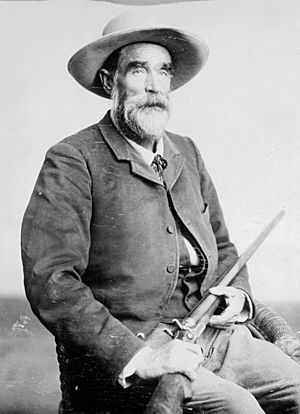Tom Jeffords facts for kids
Quick facts for kids
Thomas Jefferson Jeffords
|
|
|---|---|
 |
|
| Born | January 1, 1832 |
| Died | February 19, 1914 (aged 82) Tortolita Mountains north of Tucson, Arizona
|
| Resting place | Evergreen Cemetery, Tucson, Arizona |
| Nationality | American |
| Occupation | US Army Scout, Indian agent, prospector |
| Years active | 1876–1903 |
| Employer | Pinkerton Detective Agency |
| Known for | Brokering peace with Apache Chief Cochise |
Thomas Jefferson Jeffords (born January 1, 1832 – died February 19, 1914) was an American Army scout, a special government agent for Native Americans (called an Indian agent), and a prospector. He also managed mail delivery in the Arizona Territory. He is best known for his strong friendship with Apache leader Cochise. This friendship helped bring an end to the "Indian Wars" in that area.
Jeffords first met Cochise in 1871. He rode alone into Cochise's camp to ask the chief to come for peace talks. Cochise was worried about traveling with his family after the Camp Grant massacre. So, he said no at first. Three months later, Cochise did make the trip. He stayed for over six months. During this time, his friendship with Jeffords grew, even though the peace talks didn't work out. Cochise did not want to move his people to the Tularosa Valley.
In October 1872, Jeffords guided General Oliver O. Howard to Cochise's secret hideout in the Dragoon Mountains. Cochise demanded that the Dragoon and Chiricahua Mountains become his people's reservation. He also asked for Tom Jeffords to be their agent. Both of these requests were granted. From 1872 to 1876, there was peace in southern Arizona. After this, Jeffords worked in other jobs. He was a store owner and postmaster at Fort Huachuca. He also tried to bring water to Tucson and worked as a mine owner. He passed away in the Tortolita Mountains north of Tucson.
Contents
Early Life and Adventures
Tom Jeffords was born in Chautauqua County, New York. His family moved to Ashtabula, Ohio, when he was seven. Tom and his brothers sailed on the Great Lakes. Tom even became a ship's captain when he was in his early twenties.
Looking for excitement and wealth, Tom joined the Pike's Peak Gold Rush in 1859. He helped build a road from Leavenworth to Denver. He then followed other gold rushes to New Mexico and Arizona.
During the American Civil War, Tom was near Fort Craig. He helped as a civilian messenger in the Battle of Valverde. Colonel Edward Canby asked Jeffords to ride over 500 miles alone. He had to cross Apache land to deliver important messages. This was a very dangerous journey.
Jeffords returned to the Arizona Territory in 1862. He was a scout with the California Column, a group of soldiers. He stayed with the Army as a civilian scout throughout the war. He helped the Army deal with Native American tribes and keep Confederate forces out of New Mexico.
The Bascom Affair and Apache Wars
A major conflict with the Chiricahua Apaches began in 1861. This event is known as the Bascom Affair. Cochise, an Apache chief, was wrongly accused of kidnapping a boy. The Army sent Lieutenant George Nicholas Bascom to get the boy back.
Bascom invited Cochise to his camp for a talk. He told Cochise that he would hold him hostage until the boy and stolen livestock were returned. Cochise's family had been harmed by Mexicans during talks before. So, when he heard he would be a hostage, Cochise quickly escaped. His brother, son, and other family members were left behind as hostages.
Cochise later took his own hostages. More soldiers arrived, and a doctor named Bernard J. D. Irwin also took hostages to help. Sadly, the situation became very violent. The Apache hostages were killed by the soldiers.
Before this, Cochise had often been peaceful with white settlers. But after the Bascom Affair, he joined other Apache chiefs in fighting against them. This started a long period of war.
Working for Peace
From 1867 to 1869, Jeffords managed a mail route from Tucson to Socorro. He claimed he met Cochise during this time and made peace for his mail riders. However, his riders were still attacked often.
In 1871, President Grant sent General Oliver Howard to the Arizona Territory. His mission was to end the Apache wars by making treaties. General Howard had worked to help formerly enslaved people after the Civil War. Jeffords knew Howard was an honorable man. He believed Cochise would respect him.
Jeffords guided General Howard to Cochise's camp. A treaty was signed in 1872. This ended the ten-year war with the Chiricahua Apaches.
On December 14, 1872, President Grant created the Chiricahua Reservation. It was located in the southeast Arizona Territory. Cochise asked that his people stay in the Chiricahua Mountains. He also asked for Jeffords to be their Indian agent. These wishes were granted, and the raids stopped.
Some settlers did not like Jeffords. They called him "Indian lover" and complained to politicians. In 1875, he was removed as the federal agent. The Chiricahua Apaches were moved to the San Carlos Reservation. Cochise had died about a year before this, so he was spared the move. The Apache wars started again but ended in 1886 with the surrender of Geronimo, the last Apache leader.
Later Life and Legacy
After his time as an Indian agent, Jeffords moved to Tombstone, Arizona. He owned parts of several mines there. He had claims in the Huachuca, Dos Cabezas, and Chiricahua Mountains. He also tried to supply water to Tucson.
Tom Jeffords spent the last 22 years of his life in the Tortolita Mountains north of Tucson. He died on February 19, 1914, and was buried in Tucson's Evergreen Cemetery. A monument was placed there in his honor in 1964.

